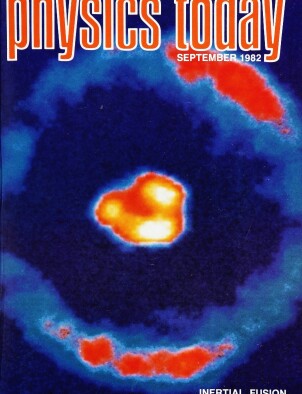The feasibility of inertial‐confinement fusion
DOI: 10.1063/1.2915258
So concluded the chairman of a Department of Energy ad hoc committee of experts in 1979, after a comprehensive review of the US inertial‐confinement fusion program. In spite of this positive evaluation, the role of inertial‐confinement fusion in the total US energy program continues to be a subject of disagreement. Before I mention the issues of contention, let me describe inertial‐confinement fusion briefly. In a typical scheme, a pea‐sized target pellet containing hydrogen isotopes is projected into a reactor chamber, where it is suddenly irradiated with an intense beam of light or ions from a “driver” (see figure 1). As the surface of the target blasts away, the rocket‐like reaction forces implode the target’s interior to densities and temperatures sufficient to cause the hydrogen nuclei to fuse, releasing an amount of energy equivalent to that of a barrel of oil (see
This article is only available in PDF format
References
1. J. S. Foster Jr, “The Promise of ICF Power,” AAAS annual meeting, San Francisco, January 1980.
2. W. D. Metz, Science 212, 517 (1981).https://doi.org/SCIEAS
3. W. C. Mead et al., Phys. Rev. Lett. 47, 18 (1981).https://doi.org/PRLTAO
4. W. Seka et al., Optics Comm. 40, 437 (1982);
N. G. Basov et al., Sov. J. Quantum Electron. 2, 429 (1973); https://doi.org/SJQEAF
C. Garban‐Labaunc et al., Phys. Rev. Lett. 48, 1018 (1982); https://doi.org/PRLTAO
D. C. Slater et al., Phys. Rev. Lett. 46, 18 (1981).https://doi.org/PRLTAO5. C. E. Max, K. G. Estabrook, Comments Plasma Phys. 5, 239 (1980).
6. M. Monsler et al., Nuclear Technology/Fusion 1, 302 (1981).
7. B. Badger, et al., HIBALL, report number UWFDM‐450/KfK‐3202, U. of Wisconsin (1981).
8. Nat. Acad. Sci., Energy in Transition 1985–2000, Freeman, San Francisco (1980).
9. R. W. Conn et al., Report number UWFDM‐220, U. of Wisconsin (1977).
10. M. I. Budyko, Meteorologiya I Gidrologiya No. 2 (1974).
11. J. Hansen et al., Science 213, 957 (1981).https://doi.org/SCIEAS
12. A. Weinberg, Science 82, May 1982, page 16.
13. J. Maniscalco et al., “The Fusion Fuel Factory–An Early Application of Nuclear Fusion That Makes Sense,” Lawrence Livermore National Laboratory report number UCRL‐87801 (1982).
14. J. Anderer, W. Häfele, et al., IIASA, Energy in a Finite World, Ballinger, Cambridge, Mass. (1981).
More about the Authors
John H. Nuckolls. Lawrence Livermore National Laboratory, Livermore, California.
